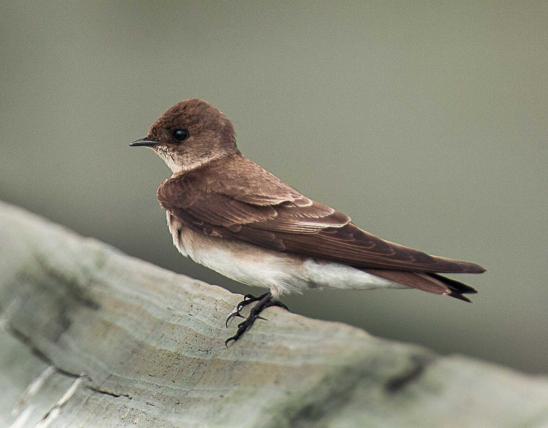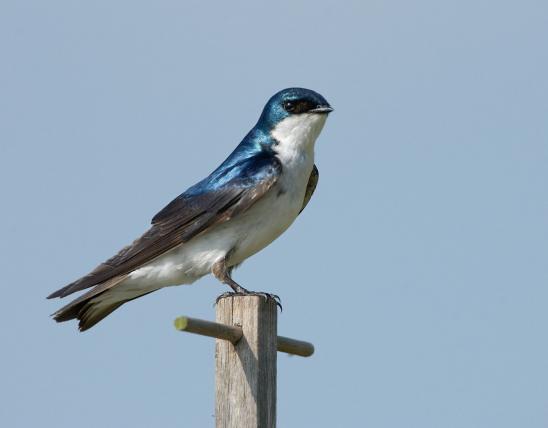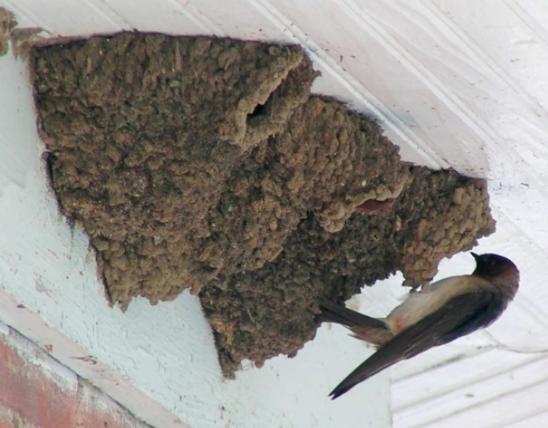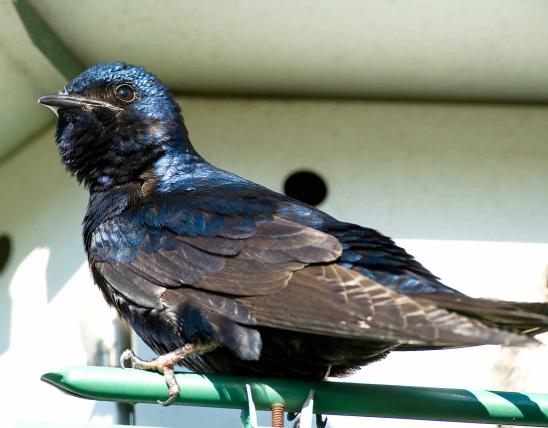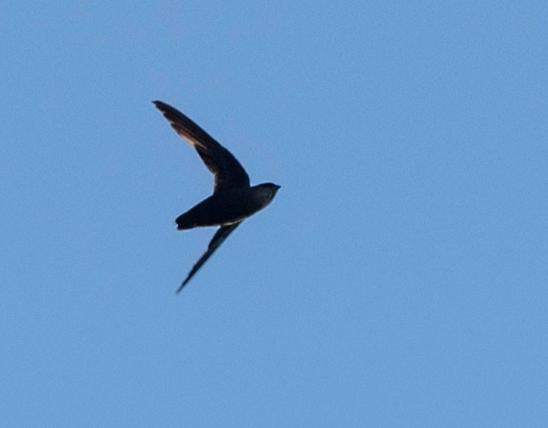
The upperparts of adult northern rough-winged swallows are brown (lighter than the upperparts of the similar bank swallow), with a brownish-white throat and whitish underparts. Compared to bank swallows, the wings are longer and appear to move more slowly, with noticeably long backstrokes with the wings, sometimes described as floppy. Voice is a low, harsh berrrt or dzzrrt.
Similar species: Bank swallows, which nest in similar places, may be distinguished by noting the characters mentioned above; also, bank swallows have a distinct dark brown band across the breast. Do keep in mind that bank swallows fly with short, quick wing strokes and appear smaller than northern rough-winged swallows.
People also sometimes confuse young tree swallows with northern rough-winged swallows. Young tree swallows have darker brown backs and whiter underparts. Tree swallows are tree cavity nesters and do not nest in steep earthen embankments.
If this is the northern rough-winged swallow, is there a southern rough-winged swallow, too? Yes, there is! It’s in the same genus and looks quite similar, but it lives mostly in South America. Honduras is the northern limit of its distribution. It, too, nests in holes in embankments.
Length: 5½ inches (tip of bill to tip of tail).
Statewide.
Habitat and Conservation
Usually seen foraging over land and water for insects. When flying over water, they tend to fly lower than other swallow species.
During migration, look carefully at mixed-species flocks of swallows. Northern rough-winged swallows are often mixed among the others. Because they are relatively drab, it would be otherwise easy to miss them.
Northern rough-winged swallows, like bank swallows and belted kingfishers, nest in holes that they excavate in the steep banks of streams where floodwaters have undercut a riverbank. These vertical banks, often called cutbanks, along streams and rivers are continually being eroded as the stream meanders along. In good years and areas, a nesting colony of these birds will nest successfully, but in some years or locations, water from a flood may undercut the stream bank, especially where vegetation has been removed, and destroy many nests in the colony.
Cutbanks are a natural part of a functioning river system. However, in a natural river system, meandering rivers may be subject to less severe flooding than those that have been channelized, as floodwaters in natural systems move relatively slowly and can spread out across the floodplain. Also, artificial stabilization of stream banks, especially when concrete riprap is laid on the shoreline to prevent erosion, typically renders the banks unsuitable for nesting swallows and kingfishers. Unchannelized stretches of streams and rivers are needed to accommodate these species.
Rough-winged swallows and bank swallows may utilize other, artificial habitats. Rough-winged swallows may utilize almost any rocky bluff or cliff, nesting in the cracks and crevices of the vertical faces. They are easily seen from a car as you pass by roadcuts on the highway. Roads that have cut through loess or sand deposits leave a vertical bank in which northern rough-winged and bank swallows excavate nests. This occurs most frequently in northwestern Missouri in the breaks and hills that parallel the Missouri River floodplain.
Food
Like other swallows, the northern rough-winged swallow forages on the wing for flying insects. They are fast, nimble fliers and use their aerodynamic skills to hunt flies, bees, wasps, true bugs, beetles, moths, mayflies, and other flying insects in the air.
Status
Common summer resident.
Life Cycle
This species nests in holes excavated in alluvial banks along rivers, loess bluffs, cliffs, rock faces created by highway excavation, and crevices on concrete bridges and culverts. They can excavate their own nest holes, or they can utilize holes made by bank swallows, kingfishers, or ground squirrels.
Except during migration, northern rough-winged swallows are not very social and live only as mated pairs or in small groups too small to be called colonies. These groups comprise only two or three pairs, often on the boundary of a colony of bank swallows, which nest in larger groups (colonies).
The nest cavity may be as deep as 40 inches and is lined with grasses, twigs, and similar materials. There is only a single brood. A clutch comprises 4–8 eggs, which are incubated about 16 days. After hatching, the young remain in the nests a further 17–22 days.
A northern rough-winged swallow may live to be at least 5 or 6 years old.
Northern rough-winged swallows, being dependent on insects for food, do not arrive in Missouri until insects are becoming active, around the end of March. Their numbers increase rapidly over the next few weeks, and nearly all have arrived by the middle of April. At the end of September, they and their surviving young are winging south for the winter, and they are gone before the end of October. Most of them overwinter in Central America and Mexico.
Human Connections
Because people are usually not fond of flying insects, they can appreciate the foraging of swallows, as they help to check populations of flying insects, especially around water.
Why the name "rough-winged"? There are tiny hooks on the feathers along the leading edge of their wings, and these feel rough to the touch. These small serrations may serve this species during courtship by producing extra sounds during their fluttery displays.
This species’ scientific discoverer was none other than John James Audubon, the great naturalist and bird artist who lived 1785–1851. He had collected several specimens of what he thought were all bank swallows, but as he examined them more closely, he saw that some were a species that had not yet been scientifically described. He gave the species its neo-Latin name, which means “saw-feathered scraper-wing,” in 1838.
The name of this bird causes us to reflect on the history of ornithology, birding, and conservation. You can’t tell this species has rough wings without feeling them with your fingers. Today, most people identify birds using field marks visible through binoculars. But a century ago, it was common for people to shoot birds and identify them, dead, using characters you could only see if you held the bird in your hand — such as the unusual serrations on the primary feathers. Drastic bird population declines (and extinctions), and the resulting conservation movement, plus the dramatic 20th-century rise in popular birdwatching and succinct field guides, led to this change in ID techniques.
Ecosystem Connections
The northern rough-winged swallow is connected to many kinds of species. It is connected to the flying insects it eats, and its migration timing is centered on their availability. A primary reason why birds migrate in spring is to take advantage of plentiful insects in their summer nesting territory. Its nesting behavior is linked to other earth-cavity nesters, such as bank swallows, kingfishers, and ground squirrels, whose old nests it sometimes utilizes. During migration, northern rough-winged swallows typically flock with other swallows as they travel for many hundreds of miles.
See Habitat and Conservation, above, for comments about their streambank habitat.



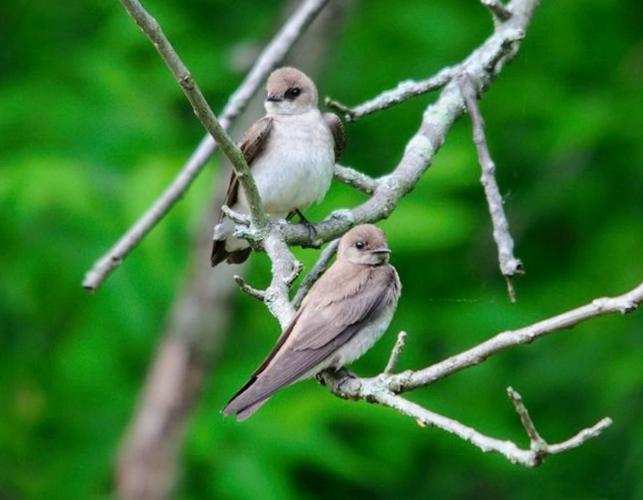
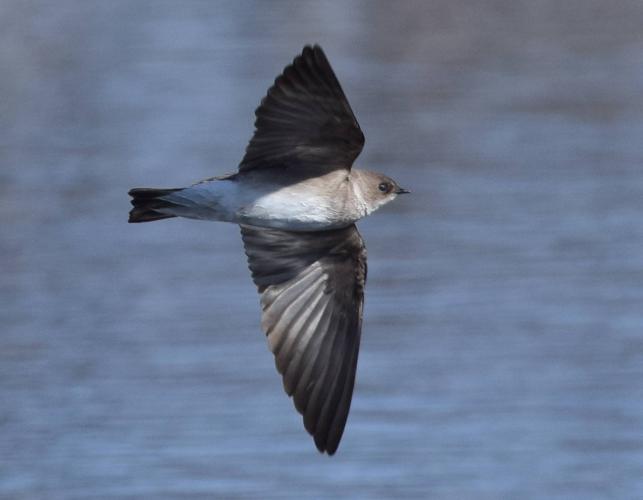



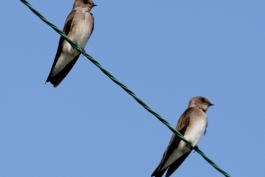

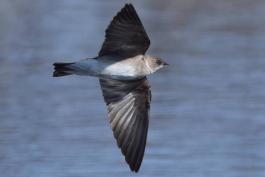
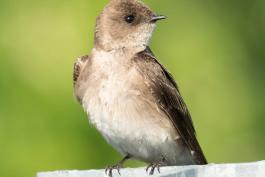
About 350 species of birds are likely to be seen in Missouri, though nearly 400 have been recorded within our borders. Most people know a bird when they see one — it has feathers, wings, and a bill. Birds are warm-blooded, and most species can fly. Many migrate hundreds or thousands of miles. Birds lay hard-shelled eggs (often in a nest), and the parents care for the young. Many communicate with songs and calls.






















